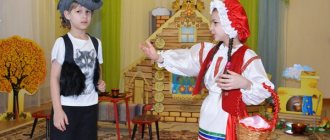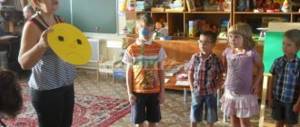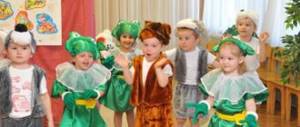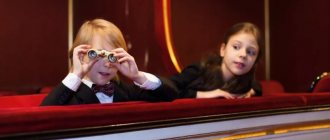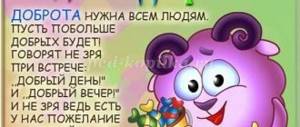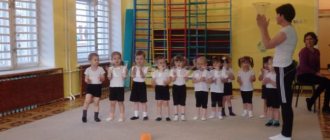Theatrical activities in the senior group in kindergarten
Theatrical activities in preschool educational institutions
Goals: • to develop creative independence, aesthetic taste in conveying the image; clarity of pronunciation; • consolidate the ability to use means of expression (posture, gestures, facial expressions, intonation, movements); • cultivate a love for the theater; • develop the independence of preschool children in organizing theatrical activities; • spiritual and moral education of preschool children, the formation of their cultural values, the development of intellectual and personal qualities. Objectives: • develop imagination, artistry, courage when performing in front of an audience; to form the creative beginning of the child’s personality; • creation of a creative atmosphere, an atmosphere of goodwill, • support of educational systems that create conditions for children to participate in creative, purposeful joint activities, their moral and aesthetic education, development of the emotional sphere, and the formation of self-confidence; • strengthening cultural ties between teachers and students’ families, supporting the organization of meaningful leisure time in the family, interest in theater and theatrical activities, events in the cultural life of the city; • organizing conditions for theatrical games, developing children's interest in visiting professional theaters. Monday
“The Magic World of Theater”
03/25/2013 Morning: Conversation “History of the Theater” (video presentation) Purpose:
to tell children about the emergence of the theater and the history of its development.
Morning exercises with elements of psycho-gymnastics. Goal:
increase psychophysical activity and mood.
(children depict animals from fairy tales, the teacher pays attention to facial expressions, pantomime, tension and relaxation of body muscles). Evening: Puppet theater "Teremok". Goal:
to develop verbal and pantomimic expressiveness;
activate speech, develop speech expressiveness; consolidate skills in manipulating bi-ba-bo dolls. Progress of the performance:
Children are asked to choose the hero of the fairy tale whom they want to voice;
remember the sequence of actions. The teacher draws the child's attention to the characteristics of the selected character. The screen is installed. Spectators take their seats. The teacher suggests turning into fairy-tale animals and starting a fairy tale. The teacher leads the main plot line, the children voice the characters. At the end of the performance, the teacher thanks the children for an interesting performance; viewers are interested in which of the characters they liked best and why. The dramatization can be repeated with other children. Tuesday
“Such a different theater”
03/26/2013 Morning: Conversations of young theatergoers about types of theaters. Purpose:
to give an idea of the different types of theaters, their purpose and purpose.
Day: Story-role-playing game “We came to the theater.” Goal:
in a playful environment, to give children an idea of the theater, the rules of behavior during the performance, and intermission.
Progress of the game:
The teacher gathers the children and informs them that today they will go to an improvised theater.
Do children know how to behave in the theater? What happens in the hall, behind the scenes? And so on. The teacher suggests distributing roles between the participants in the game. The game takes place with the direct participation of the teacher who directs the gaming activity. Upon completion, the results are summed up. Evening: Entertainment game-dramatization “Rukavichka” (“Winter quarters”). Goal:
to develop the expressiveness of children’s speech and pantomime;
consolidate knowledge of the content of a fairy tale, the ability to use the attributes of the theater. Progress of the dramatization game:
The teacher offers to name magical objects with which you can get into a fairy tale.
Children call. Then the teacher takes out masks and invites the children to turn into animals from the fairy tale “Rukovichka”. Helps children during dramatization play. At the end, he thanks everyone for the interesting performance. Wednesday
“We are artists, we are spectators!”
03/27/2013 Morning: A surprise moment: introducing children to a “living hand” doll. Goal:
to talk about the variety of puppets in the theater, to give an idea of how to manipulate a given doll.
Psycho-gymnastics “Leopold the Cat and the Mice.” Goal:
to develop pantomimic expressiveness, the emotional, communicative sphere of children, to teach how to regulate muscle tension and relaxation;
determine the nature of movements in accordance with a given image; develop imagination. Day: Drawing competition “The Magical World of Theater”. Goal
: to enable children to convey in their drawings their vision of the theater, the stage, and the characters of the performances;
development of creative and graphic abilities. Evening: Dramatization games, director's games using a doll with a living hand. Goal:
to develop imagination, pantomimic expressiveness.
Progress of the dramatization game:
The teacher suggests remembering what the children learned about the doll “with a living hand.”
Those interested are invited to play, a screen is set up. Children are invited to come up with and act out a plot. Further, the game can go beyond the “theater”, i.e. Children can use the live hand doll for their games. Thursday
“Master of Puppet Affairs”
03/28/2013 Morning: Psycho-gymnastics “Saving kindness.” Goal: to distinguish and name the emotions of pleasure, surprise, admiration and joy, to respond adequately to them; develop attention, learn to relax. Making figurines for the theater on flannelgraph. Goal: to instill a love of manual labor, to arouse interest in creative activities; learn to highlight the characteristics of a character when making figurines. Evening: Theater on flannelgraph based on nursery rhymes and poems. Goal:
consolidate knowledge of nursery rhymes and poems;
develop children's speech, expressiveness, artistry, and develop imagination. Progress of the game:
The teacher draws the children’s attention to the house and the doll on the flannelgraph.
Talks about her. Gives riddles to children. The answers are placed on a flannelgraph. Then the teacher invites the children to perform a nursery rhyme about the chosen hero. At the end, the doll invites everyone to drink tea. The theater smoothly transitions into the game. Friday “Theater, theater!” 03/29/2013 Morning: Exhibition - presentation in the group of different types of theater “Play with us!” Goal: to show the diversity of theaters in the group. Photo collage “Give us applause!” Purpose:
to show the work of teachers and children in theatrical activities organized in a group.
Psycho-gymnastics. Sketches: “Flower”, “The Kitty Woke Up”, etc. Purpose:
to develop imagination, the ability to adequately express emotions of pleasure and joy;
be able to plastically convey transformations. Evening: Theatrical games using human dolls Purpose:
to give an idea of a new type of doll: “human dolls”;
develop imagination, pantomimic expressiveness; be able to organize your theatrical activities taking into account the chosen character. Progress of the game:
Show children costumes for human dolls; talk about their use and purpose. Tell us how it can be used in theatrical games; where can you find similar dolls? Offer to organize a game using the proposed costumes. If the children find it difficult, offer to stage it, act out a fragment from a cartoon with a similar character. Finally, make a comparison between different types of theater; different dolls: which one you like best, which one is more interesting to play with; which Cookom can be used in everyday gaming activities. * * * * * Development of poster information for parents on issues of supporting the organization of meaningful leisure time in the family, interest in theater and theatrical activities.
We recommend watching:
Master Class. DIY shadow theater
Photo report from the fairy tale “The Scarlet Flower” Synopsis of a theatrical lesson in the second junior group Synopsis of a joint theatrical activity in a preparatory group on Russian folk tales
Similar articles:
The fairy tale “At the behest of the pike” in a new way. Role-based script for older preschoolers
Theater project
Theatricalization provides great material for project activities in the middle group. These can be short-term or long-term projects. The duration of short-term - from one day to two weeks, long-term - from two weeks to six months and even a year.
An example of a long-term project is “Theater near us” by Educator I. G. Gimaeva. It involves children, teaching staff and parents. At the same time, parents are involved in the creation of fairy tale characters, the exhibition of drawings “We are from a fairy tale,” and the organization of a photo exhibition “To the puppet theater with the whole family.”
Problem to be solved during the project: inability to convey the emotional character of the characters, insufficient vocabulary, difficulties in coherent speech.
The teacher has developed a detailed project plan, including scenarios for open events, and thought through the expected results of the activity. During the preparatory stage, the teacher creates various types of theater in the group (parents and preschoolers themselves are involved in this process), reads fairy tales and short stories to preschoolers - future scripts for performances.
Table: fairy tales for theatrical performances used in the project
| Month | Fairy tale title | Theater view |
| September | Belarusian fairy tale “Pykh” | puppet show |
| October | Russian folk tale "Turnip" | cardboard theater |
| November | "Teremok" | puppet show |
| December | "Zayushkina's hut" | finger theater |
| January | "Winter quarters of animals" | finger theater |
| February | "Kolobok" | finger theater |
| March | Fairy tale by L. N. Tolstoy “Three Bears” | cardboard theater |
| April | T. Karamanenko's story “The Hedgehog and the Fungus” | finger theater |
| May | "Masha and the Bear" | dramatization, the final stage of the project |
During the implementation of the project, theatrical activities are closely intertwined with artistic creativity (children are offered coloring books on the theme of fairy tales, drawing of their favorite characters), physical education (physical education minutes on fairy tale themes).
Card index of theatrical games
According to experts, the “Theatrical Games for Children” card file contributes to the development of attention, endurance, and coordination of actions. The following theatrical children's games in the middle group can be distinguished:
Card index
"Hands-legs"
The main goal is to develop active attention and reaction speed.
With one clap, the guys should raise their hands, with two clap, they should immediately stand up. If your hands are raised: one at a time, lower your hands; two at a time, sit down.
"A fun game with chairs"
During the course of work, the kindergarten teacher instills the ability to move freely in space. Coordination of actions is very important here. Children must learn to sit gracefully on chairs, build given figures, etc.
Drawing lessons in the senior group on the topic “Indoor plants”
Note! At the teacher’s command, the children must carefully move around the hall with their chairs and “build” a circle (sun), a house for a doll, an airplane, a bus.
"What do you hear"
This lesson provides auditory attention training. The guys should sit next to each other and listen to the sounds.
Exercise with objects
This lesson is aimed at training visual attention. The teacher lays out several objects on the table. Among them you can find:
- pencil;
- notebook;
- watch;
- matches;
- coin
The child driving should turn away at this time. The teacher suggests going to the table to look at the object and remember its shape, color, location. After which the child must turn away again, and the teacher, meanwhile, removes one of the presented objects. The preschooler must guess which item is missing.
"Pass the Pose"
By completing this task, children develop qualities such as memory, attention, observation, imagination, and endurance. The teacher sits the children on chairs, creating a semicircle. At the teacher’s command, the children must close their eyes. The driving child must independently come up with and fix a certain pose, showing it to the first peer. Accordingly, the friend must remember and show it to the other child. Therefore, there is a comparison of the poses of the last player with the pose of the driver.
"Remember the photo"
The main goal of this exercise is to develop voluntary attention, imagination and fantasy. The guys must perform all actions in a coordinated manner.
Note! Before starting the task, the teacher divides the preschoolers into several groups, each consisting of 4-5 people. Children must choose one photographer themselves. He must arrange his group in a certain order and make cards.
While doing the work, the child must remember the location of the group. The teacher asks the “photographer” to turn in the other direction. The guys immediately change positions and take other poses. The “photographer” must reproduce the original version.
